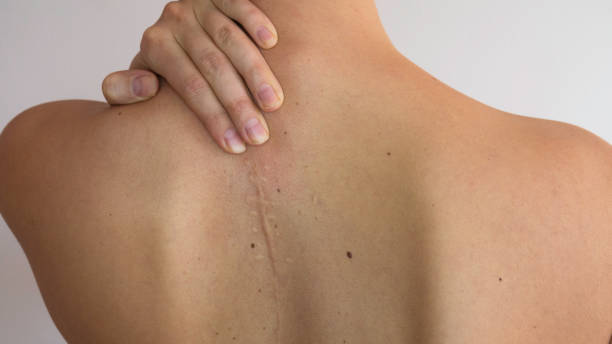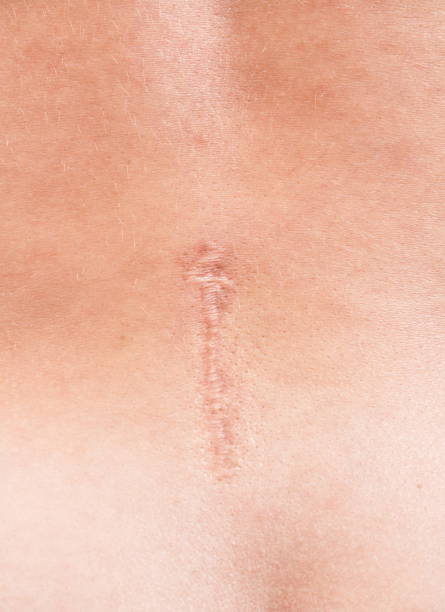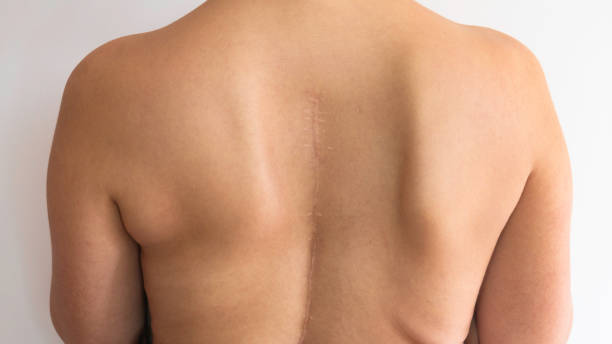
Surgery For Spinal Stenosis Pictures, Images and Stock Photos
Browse 60+ surgery for spinal stenosis stock photos and images available, or start a new search to explore more stock photos and images.

spinal canal stenosis from Herniated disc displacement disease in hospital room
Degenerative disc disease (DDD) is a condition that occurs when the spinal discs break down and cause pain. It's the most common cause of low back pain worldwide and can also affect the neck, legs, and buttocks.
A bulging disc, also known as a herniated, slipped, or ruptured disc, is a condition that occurs when the nucleus of the intervertebral disc bulges out through a tear in the disc's outer ring. This can happen as the spine ages and the disc loses fluid and dries out, compressing the spongy disc that acts as a shock absorber.
Doctor neurosurgeon holds a scalpel in the background of the patient's back, the concept of removal and replacement of the intervertebral disk for artificial, endoprosthetics and spinal surgery, spinal cord
big collection x-ray image on black or dark background, hight quality of human anatomy by x-ray
A bulging disc occurs when the tough outer layer of a spinal disc weakens and the inner portion begins to push out. This can lead to pain and discomfort, as well as potential nerve compression.
A bulging disc occurs when the tough outer layer of a spinal disc weakens and the inner portion begins to push out. This can lead to pain and discomfort, as well as potential nerve compression.
Disc degeneration with osteophyte formation, also known as disc osteophyte complex, is a spinal condition that occurs when bone spurs, or osteophytes, form on the spine. These spurs are a sign of spinal degeneration and are often a symptom of a deeper problem.
A herniated disc, also known as a slipped disc, occurs when a disc in the spine is forced through a weakened part of the disc, putting pressure on nearby nerves or the spinal cord. It's a common cause of back pain and can cause weakness and numbness in the arms or legs. In severe cases, a herniated disc can cause paralysis.
Thinning discs are a natural result of aging and a type of degenerative disc disease (DDD). As people age, the gel-filled centers of the intervertebral discs lose hydration and the outer shells weaken and become brittle. This compromises the discs' ability to cushion the vertebrae.
Degenerative disc disease (DDD) is a type of arthritis that occurs when the spine's joints wear out. The discs in the spine, also known as intervertebral discs or spinal discs, act as shock absorbers between the vertebrae, which provide rigidity. As people age, the discs change shape and become less organized, and they lose proteoglycan, which affects their ability to bear weight.
Disc degeneration with osteophyte formation, also known as disc osteophyte complex, is a spinal condition that occurs when bone spurs, or osteophytes, form on the spine. These spurs are a sign of spinal degeneration and are often a symptom of a deeper problem.
Degeneration with osteophyte formation disc disease, also known as arthritis, is a condition that causes bone spurs, or osteophytes, to form on the spine. These spurs are a sign of spinal degeneration and can limit joint movement and cause pain.
A herniated disc, also known as a slipped disc, occurs when a disc in the spine is forced through a weakened part of the disc, putting pressure on nearby nerves or the spinal cord. It's a common cause of back pain and can cause weakness and numbness in the arms or legs. In severe cases, a herniated disc can cause paralysis.
A herniated disc, also known as a slipped or ruptured disc, occurs when the jelly-like substance in a spinal disc is forced through a weakened part of the spine. This can happen anywhere in the spine, but it's most common in the lower back, especially between the fourth and fifth lumbar vertebrae and between the fifth lumbar vertebra and the first sacral vertebra.
A thinning disc can affect the spine by compromising the disc's ability to cushion the vertebrae. This can lead to pain, numbness, weakness, or other symptoms depending on which spinal disc is affected.
A bulging disc is a condition in which the inner portion of the intervertebral disc begins to protrude from the outer wall of the disc. This condition usually develops over time and can cause other disc degeneration conditions, such as spinal stenosis.
A bulging disc is a condition in which the inner portion of the intervertebral disc begins to protrude from the outer wall of the disc. This condition usually develops over time and can cause other disc degeneration conditions, such as spinal stenosis.
A herniated disc, also known as a slipped or ruptured disc, occurs when the nucleus of a disc is forced through a weakened part of the spine. This can put pressure on the spinal cord or nearby nerves, which can cause pain, numbness, weakness, or changes in sensation.
A thinning disc can affect the spine by compromising the disc's ability to cushion the vertebrae. This can lead to pain, numbness, weakness, or other symptoms depending on which spinal disc is affected.
A spine affected by a degenerative disc is characterized by the breakdown of the intervertebral discs between the vertebrae. This condition is often associated with aging and can result in reduced disc height and flexibility. As the discs degenerate, they may lead to symptoms such as back pain, stiffness, and reduced mobility.
A spine affected by disc degeneration with osteophyte formation is experiencing a common consequence of aging and wear on the spinal discs. Intervertebral discs deteriorate, losing height and elasticity, which can lead to the formation of bony outgrowths called osteophytes or bone spurs. These osteophytes can impinge on nerves, causing pain, tingling, or numbness.
Thinning discs are a natural result of aging and a type of degenerative disc disease (DDD). As people age, the gel-filled centers of the intervertebral discs lose hydration and the outer shells weaken and become brittle. This compromises the discs' ability to cushion the vertebrae.
A bulging disc, also known as a herniated, slipped, or ruptured disc, is a condition that occurs when the nucleus of the intervertebral disc bulges out through a tear in the disc's outer ring. This can happen as the spine ages and the disc loses fluid and dries out, compressing the spongy disc that acts as a shock absorber.
Degenerative disc disease (DDD) is a type of arthritis that occurs when the spine's joints wear out. The discs in the spine, also known as intervertebral discs or spinal discs, act as shock absorbers between the vertebrae, which provide rigidity. As people age, the discs change shape and become less organized, and they lose proteoglycan, which affects their ability to bear weight.
A bulging disc is a condition in which the inner portion of the intervertebral disc begins to protrude from the outer wall of the disc. This condition usually develops over time and can cause other disc degeneration conditions, such as spinal stenosis.
A bulging disc is a condition in which the inner portion of the intervertebral disc begins to protrude from the outer wall of the disc. This condition usually develops over time and can cause other disc degeneration conditions, such as spinal stenosis.


























































